Dr Nicholas Spitzer – Neurotransmitter Switching: A New Form of Brain Plasticity
The discovery that the brain can change and reorganise itself revolutionised our understanding of neuroscience. Termed neuroplasticity, the field has seen an explosion of interest. An exciting form of plasticity has now been identified, in which neurons change their chemical communicator in response to environmental stimuli. Dr Nicholas Spitzer of the University of California, San Diego and his colleagues are looking to understand what causes this, what the effects are, and whether we can harness this exciting new facet of neurobiology to develop novel therapeutics for neurologic and psychiatric disorders.
A Changing Landscape
The human brain is the most complex and least well understood organ in the body. It contains almost 100 billion neurons and anywhere between 100 and 1000 trillion connections between them. Neurons in the brain are often identified by the specific chemical communicators they release, known as neurotransmitters. Dopaminergic neurons signal with dopamine and serotoninergic neurons signal with serotonin.
The prevailing view has been that this neurotransmitter identity is fixed. But just as it was previously contended that the adult brain is static and unmalleable, research is pointing towards a very plastic brain, one which can change and adapt over time – including the ability of neurons to switch their neurotransmitter and change their function. Dr Nicholas Spitzer and his colleagues from the University of California, San Diego, have been investigating this process, termed neurotransmitter switching, to find out what causes this switch, where it happens, and what the downstream effects are.
‘The discovery of neurotransmitter switching in the adult mammalian brain identified a previously unrecognised form of brain plasticity at the synapse,’ says Dr Spitzer. This newfound realm of plasticity opens-up avenues for research in neurological and psychiatric disorders and potential new treatments. His team is looking for links to the chemical imbalances we often see in psychiatric disorders, like depression, and questioning whether neurotransmitter switching may play a role in the development or the treatment of such disorders.
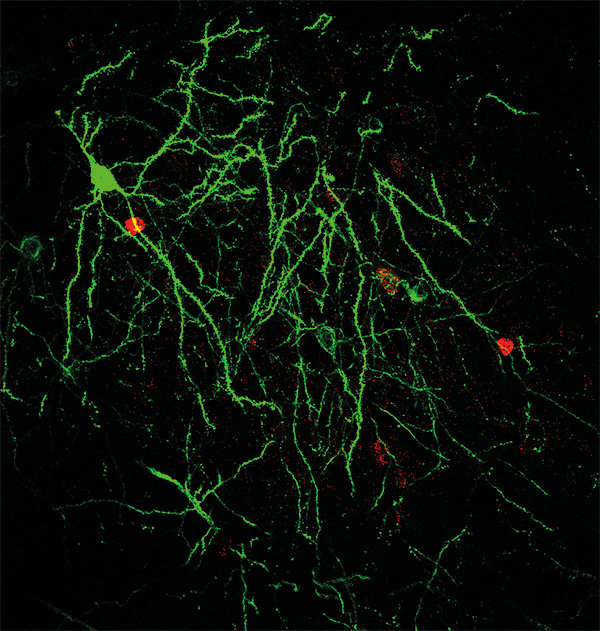
Strategy to label neurotransmitter switching neurons. The image shows glutamatergic pyramidal neurons labelled in green. These neurons have been marked using a viral vector strategy that makes them express a green fluorescent protein. The sparse red dots are neurons that express the inhibitory neurotransmitter GABA. When a glutamate-to-GABA neurotransmitter switch occurs, we see the green pyramidal neurons start expressing red and appearing yellow. Credit: Dr Marta Pratelli.
Chemical Conversations
‘All our thoughts, emotions, and memories are the result of electrical activity in brain circuits,’ says Dr Spitzer; ‘these circuits are composed of neurons connected by synapses.’ The interaction between neurons at the synapse is crucial in allowing the billions of individual cells to communicate and coordinate with each other. The synapse is the very small space between two neurons and is perfect for quickly exchanging signals.
A single neuron can have synapses with hundreds or thousands of other neurons, allowing extremely complex pathways to form. When a signal in the form of electrical activity reaches the end of one neuron it must traverse the synapse to get to the next. To do so, a specialised group of chemical compounds called neurotransmitters come into play, which are released from the end of one neuron to cross the synapse and bind to specific receptors on the neuron on the other side.
An important property of neurotransmitters is that they can be divided into two classes: excitatory and inhibitory. As the name suggests, excitatory neurotransmitters will propagate a signal at the synapse and ‘carry on the conversation’ into the connecting neuron and beyond, while an inhibitory neurotransmitter will halt the signal at that synapse. Glutamate, dopamine and serotonin are some of the most well-known excitatory neurotransmitters, due to their roles in mood regulation, while GABA (gamma aminobutyric acid) is the major inhibitory transmitter in the brain.
Plasticity at the level of the synapse is a well-known concept in the field of neuroscience, and researchers have consistently observed synaptic changes that can either amplify or reduce an incoming signal. Critically, learning and memory take advantage of this property. As Dr Spitzer explains, ‘When we learn something, electrical activity causes physical changes in the brain, often referred to as brain plasticity. Much of brain plasticity occurs at the synapse, changing the number of synaptic connections and strengthening or weakening them.’ The ability of the brain to change and reorganise allows it to respond to things more effectively in the future.
These changes often involve alterations to the number of receptors present in the synapse. It is only recently that the ability of neurons to change their neurotransmitter has been revealed in the adult mammalian brain. Interestingly, neurotransmitter switching almost always seems to swap an excitatory transmitter out for an inhibitory transmitter or the other way around. These switches determine whether the signal at the synapse will be continued or not and may be responsible for the behavioural changes we see down the line.
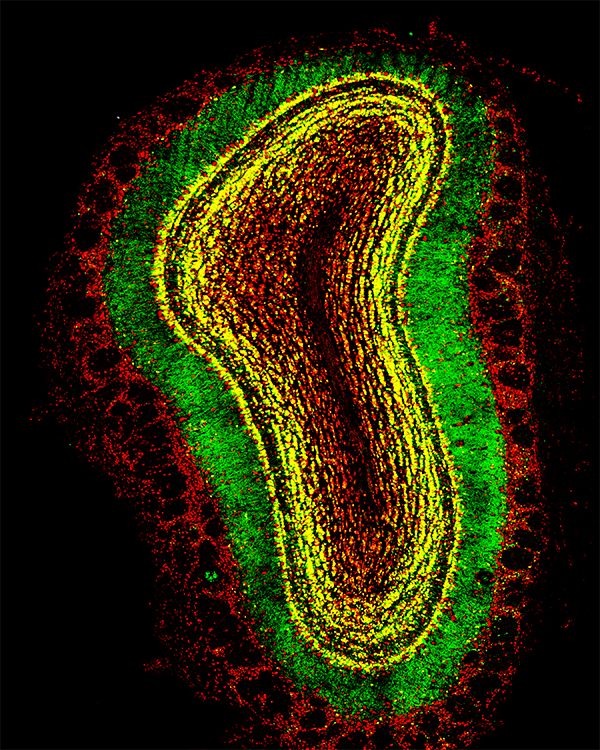
Strategy for whole-brain investigation of glutamate-to-GABA neurotransmitter switching. This image shows a coronal section of the olfactory bulb. The mouse from which the image has been taken was genetically modified so that neurons that are or were glutamatergic are labelled by a red fluorescent protein and the cells that can produce GABA at the time of the analysis are labelled in green by a different fluorescent protein. This allows visualisation of green + red = yellow in cells that are or were glutamatergic and now produce GABA. Credit: Dr Marta Pratelli.
Brain Training
A crucial element of neurotransmitter switching is that it occurs naturally, and probably all the time. Everything we see, hear, and do is a stimulus from the environment which is converted into electrical activity in our brain. If this stimulus is prolonged or repetitive the neurons may switch their neurotransmitter to change the behavioural output.
In a study on motor skill learning, Dr Spitzer’s team wanted to examine the effects of sustained wheel-running in mice. What they saw was a subsequent enhancement when learning more difficult motor skills, like balancing on a beam, in the week after running.
The continuous stimulation from running was enough to cause an uptick in activity in brain areas associated with movement, particularly in an area called the pedunculopontine nucleus which is involved in gait and balance. Using an array of molecular and genetic tests they determined that a large number of the neurons here which normally express acetylcholine, an excitatory transmitter, had switched to expressing GABA, an inhibitory transmitter.
To test the causal connection of the switch to enhanced learning, they tested what would happen if this change were prevented from happening by blocking the enzyme required to synthesise GABA. In these mice, neurotransmitter switching did not occur and their ability to learn new motor skills was not enhanced.
‘Sustained running causes transmitter switching in the midbrain of adult mice that facilitates learning of other motor skills’, Dr Spitzer explains. But the role of neurotransmitter switching in improving movement control is not where it ends, as he notes, ‘Transmitter switching can have either beneficial or detrimental effects.’
‘The discovery of neurotransmitter switching in the adult mammalian brain identified a previously unrecognised form of brain plasticity at the synapse.’
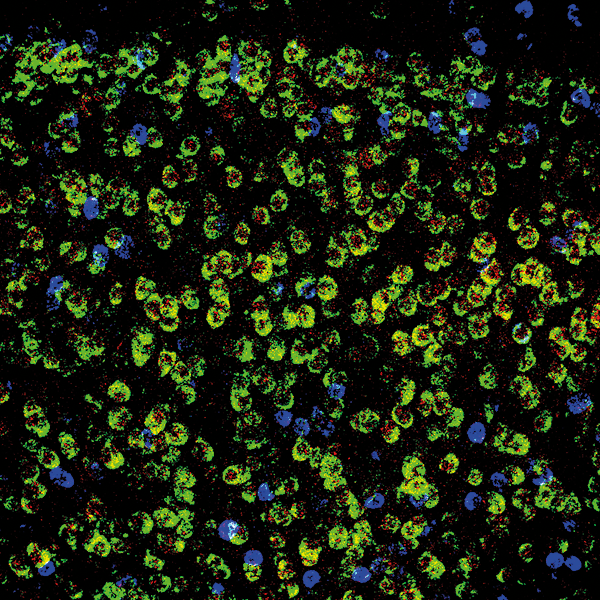
Analysis of mRNA expression levels in prefrontal cortex neurons that switch from glutamate to GABA. The cells in blue are neurons that express a GABAergic marker (GAD1), while green fluorescence permanently labels neurons that are glutamatergic or were glutamatergic in the past. The dot-like red signal shows the expression of a glutamatergic marker (vGluT1). By measuring the number of red dots present, one can determine whether the expression level of the glutamatergic marker (vGluT1) is decreased in switching neurons. Credit: Dr Marta Pratelli.
Light Therapy
One of Dr Spitzer’s first discoveries relating to neurotransmitter switching in the adult brain was the effect of changing day lengths on mood. Seasonal affective disorder (SAD) is a form of depression which often recurs when the days get shorter and exposure to sunlight is reduced. Dr Spitzer wanted to know whether this environmental change was triggering unwanted neurotransmitter switching in areas of the brain involved in mood regulation.
He found that in rats, changing the amount of light they were exposed to each day caused dopaminergic neurons to switch to somatostatin expressing neurons. This occurred primarily in an area of the brain which detects light hitting the retina and regulates daily bodily rhythms. Importantly, these rats went on to express more depressive-like and anxious behaviour, spending less time in open spaces and exerting less energy.
In humans, changing day lengths can have similar effects on mood, and post-mortem brain tissue from people who died of natural causes in either summer or winter provides fascinating further insight. Those who died in summer were, at the time of their death, exposed to more sunlight; consequently, they had increased numbers of dopaminergic neurons in the same brain region than those who died in winter. This ties in nicely with current theories of depression which suggest that reduced activity in dopaminergic circuits can have detrimental effects on mood. Unfortunately, stress-induced transmitter switching appears to be more stable than its beneficial counterpart, but that is not to say it cannot be reversed.
Armed with the knowledge that light exposure can manipulate mood, light-based treatments (known as phototherapy) have now been developed to treat SAD which involve sitting in front of a bright light for a few hours per day. Phototherapy may be effective in reducing the symptoms of SAD by reversing or preventing detrimental transmitter switching in the darker months. This new approach to tackling mood disorders benefits from being easy to implement and avoids the many issues associated with standard drug treatments. For periodic mood disorders like SAD, phototherapy seems to tick all the boxes.
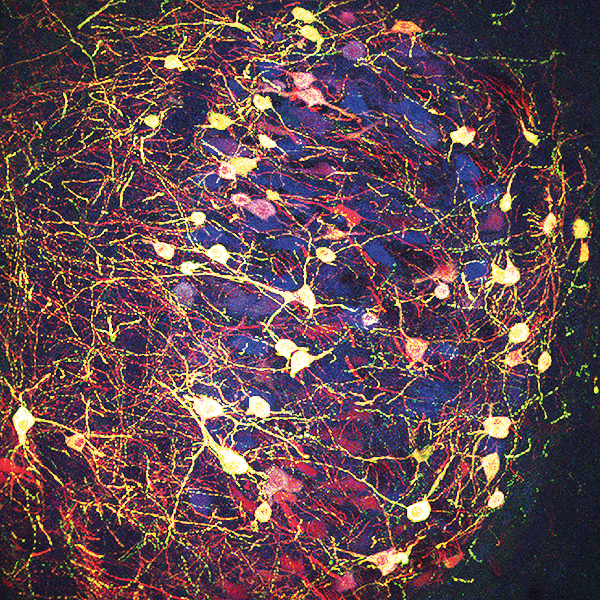
Imposing a neurotransmitter switch. A group of midbrain neurons expressing acetylcholine (blue) are made to express another neurotransmitter, glutamate (green), using adeno-associated virus as a gene delivery platform. The neurons targeted by the virus also express a red fluorescent protein for identification and thus appear a light-yellow colour (green plus red and blue). Credit: Dr Hui-quan Li.
The Way Forward
Beyond the compelling results from experiments so far, Dr Spitzer and his colleagues have identified key questions which remain to be answered. These include the cellular location and speed of the switches; the pathways involved in changing from one neurotransmitter to another; whether switching changes as we age; and perhaps most importantly, how this phenomenon could be used to understand human brain disorders and develop new therapies.
A huge hindrance to getting these answers is the tools currently available; future advances in imaging technologies and genetic mouse models may be necessary to allow high-throughput screening of transmitter switching to gain representative results.
The potential for non-invasive behavioural therapy is especially exciting to neurologists and psychiatrists. Based on data so far, we can see how sensory stimuli like exercise and day length can result in behavioural changes. Indeed, there are already myriad studies demonstrating the benefits of light therapy for SAD and showing that sustained exercise therapy can help ameliorate Parkinson’s Disease and stroke symptoms.
The role of neurotransmitter switching seems to be linked to many psychiatric conditions we know about. ‘It seems natural to want to know whether transmitter switching is generating this chemical imbalance, in autism spectrum disorder, posttraumatic stress disorder and behavioural consequences of drug abuse,’ explains Dr Spitzer. If it is, we can focus on developing our understanding of the mechanisms and the behavioural changes it can produce, allowing us to manipulate it for our benefit and enter a new era of treatment for brain-based disorders.
Reference
https://doi.org/10.33548/SCIENTIA556
Meet the researcher
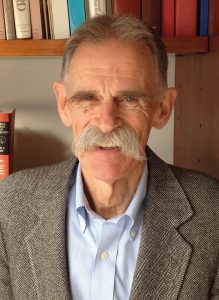
Dr Nicholas C. Spitzer
Neurobiology Section
Division of Biological Sciences
University of California, San Diego
San Diego, CA
USA
Dr Nicholas C. Spitzer earned his PhD from Harvard University in Neurobiology and went on to work as a postdoctoral fellow at Harvard University and then University College, London. In 1972 he took up a faculty position at the University of California, San Diego, where he now holds the post of Atkinson Family Chair Distinguished Professor of Biological Sciences and Director of the Kavli Institute for Brain and Mind (KIBM). His research is focused on understanding the role of environment in behaviour disorders and advancing study of neurotransmitter switching, a newly appreciated form of neuroplasticity. He is a member of the National Academy of Sciences, the American Academy of Arts and Sciences, and a fellow of the American Association for the Advancement of Science. Dr Spitzer has published prolifically in top scientific journals including Nature and Science, and has received a number of accolades for his research.
CONTACT
W: http://www.nickspitzerlab.org/
KEY COLLABORATORS
Laura N. Borodinsky, Department of Physiology and Membrane Biology, UC Davis School of Medicine
Davide Dulcis, Department of Psychiatry, UC San Diego School of Medicine
Stefan Leutgeb, Neurobiology Section, UC San Diego
FUNDING
W.M. Keck Foundation
Ellison Medical Foundation
National Institute of Neurological Disorders and Stroke (NINDS, NIH)
National Institute on Drug Abuse (NIDA, NIH)
Further Reading
H Li, NC Spitzer, Exercise Enhances Motor Skill Learning by Neurotransmitter Switching in the Adult Midbrain, Nature Communications, 2020, 11, 2195.
H Li, M Pratelli, S Godavarthi, et al, Decoding Neurotransmitter Switching: The Road Forward, Journal of Neuroscience, 2020, 21, 4078–4089.
D Dulcis, P Jamshidi, S Leutgeb, N C Spitzer, Neurotransmitter Switching in the Adult Brain Regulates Behaviour, Science, 2013, 340, 449–453.
LN Borodinsky, CM Root, JA Cronin, et al, Activity-dependent Homeostatic Specification of Transmitter Expression in Embryonic Neurons, Nature, 2004, 429, 523–530.

Want to republish our articles?
We encourage all formats of sharing and republishing of our articles. Whether you want to host on your website, publication or blog, we welcome this. Find out more
Creative Commons Licence
(CC BY 4.0)
This work is licensed under a Creative Commons Attribution 4.0 International License. 
What does this mean?
Share: You can copy and redistribute the material in any medium or format
Adapt: You can change, and build upon the material for any purpose, even commercially.
Credit: You must give appropriate credit, provide a link to the license, and indicate if changes were made.
More articles you may like
Grandmothers: Innovation Through Tradition
Grandmother Project – Change through Culture (GMP) is an organisation dedicated to documenting the role of grandmothers and demonstrating the effectiveness of grandmother-inclusive strategies in improving the health and well-being of women, children, and adolescents. GMP’s groundbreaking work challenges conventional wisdom to transform community-based interventions in Africa and beyond, harnessing a powerful but often overlooked resource: the wisdom and influence of grandmothers.
Dr Robert Larkin | Cultivating Change to Improve Soil Health and Increase Potato Yield
Environmental quality and food production are facing the pressing challenges of climate change and global population growth. Dr Robert Larkin from the United States Department of Agriculture-Agricultural Research Service (USDA-ARS) and a team of plant scientists developed and tested a range of crop management systems to help overcome these compounding challenges. Their work is improving soil health and increasing the yield of potato crops, contributing to the future food security of nations.
Professor Giorgio Buttazzo | Artificial Intelligence and a Crossroads for Humanity
Where do we stand with artificial intelligence? Might machines take over our jobs? Can machines become conscious? Might we be harmed by robots? What is the future of humanity? Professor Giorgio Buttazzo of Scuola Superiore Sant’Anna is an expert in artificial intelligence and neural networks. In a recent publication, he provides considered insights into some of the most pressing questions surrounding artificial intelligence and humanity.
Dr Ralf Adam | New Technologies Shaping the Future of Oral Hygiene
Understanding the efficiency of various toothbrush technologies is essential for achieving optimal oral health. Dr Ralf Adam, who leads a dedicated team at Procter & Gamble in Germany, is keen to investigate the complexities of these technologies. His team have provided new insights into the best toothbrush types for plaque removal and the maintenance of gum health. By highlighting the importance of informed oral care decisions and ongoing investigations, this vital research works towards ensuring everyone can achieve a brighter, healthier smile.




